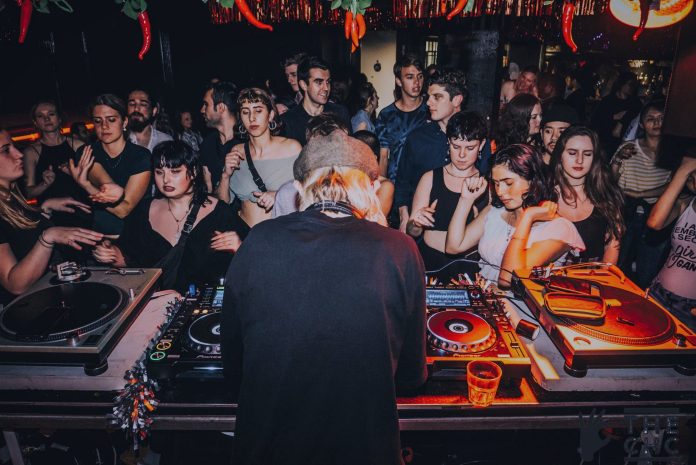Many experiences can define a night out in Sydney’s Inner West suburb of Newtown: sitting in the Courthouse beer garden until close; drinking cheap schooners and playing pool at the Townie; shots of ouzo with Greek locals at Steki’s; jumping on stained red carpet at the Enmore Theatre; fluorescent silent disco headphones at Sly Fox; a kebab from Istanbul on King; or dancing until 5 am in the Tokyo Sing Song glitter dungeon.
Described by the NSW Government’s Joint Select Committee on Sydney’s Night Time Economy as “a lively entertainment hub” with a “successful night-time economy”, Newtown is renowned for its vibrant nightlife. The committee’s official report reviewing Sydney’s 2014 lockout laws, released on September 30, notably commended the suburb as an exemplar for lockout law affected areas moving forward.
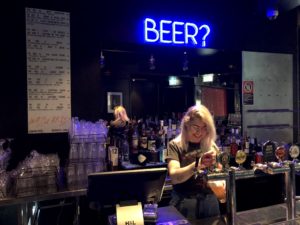
After receiving 793 submissions, the committee recommended: “The 2014 laws be removed in the Sydney CBD and Oxford Street to facilitate increased patronage at a diverse range of venues to enhance Sydney’s night time economy.” For Kings Cross, the strip most notoriously associated with the implementation of the NSW laws, the 1.30am lockouts and 3am service cut-off will remain enforced.
As one of the few late-night alternatives for patrons locked out of city venues, Newtown became one of the primary beneficiaries of the lockout laws. “There was a 300 per cent increase in the turnstile at Newtown train station in the first year after the lockout laws,” says Amanda Verratti, general manager and licensee of the Bank Hotel on King Street.
In a 2018 report on late-night trading premises by the City of Sydney Council, a survey of 5,331 respondents ranked Newtown as the number one late-night trading area. And 30 per cent of respondents chose the suburb when asked “what’s your favourite area to go out?”
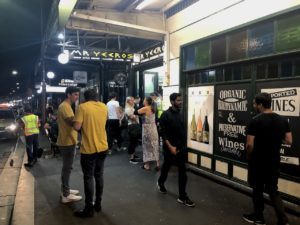
But with this movement of patronage comes the risk that violence and alcohol-related crime are also displaced to surrounding areas. According to the NSW Bureau of Crime Statistics and Research (BOCSAR), non-domestic assaults in distal displacement areas such as Newtown, Coogee, Bondi, and Double Bay increased 30 per cent between January 2014 and March 2019.
A closer look at Newtown reveals a different story. Using BOCSAR’s NSW Crime Tool Map, the rate of non-domestic/alcohol-related assaults in the postcode of 2042 has remained stable since the introduction of the lockout laws. That rate also remains stable when specifying ‘weekend night’ and on ‘licensed premises’.
According to the Inner West Police’s crime statistics, there’s been a 24 per cent decrease in all alcohol-related crime in the area over the past two years. These statistics only account for arrests and reported crimes.
Speaking to the Joint Select Committee, the City of Sydney’s night-time manager Libby Harris attributes the violent nature of Kings Cross prior to the lockout laws to the area’s culture of drinking and lack of late-night public transport. She also blames the fact that “it was the last place to go in the city that was open at night”.
So, what happened when Newtown inherited being ‘the last place open’?
“We’ve been an incredible case study on being an area that is fun and open late but is still a safe place for people to go out and not be stressed about violence,” says Verratti, who was also previously general manager at the Marlborough Hotel and Courthouse Hotel in Newtown.
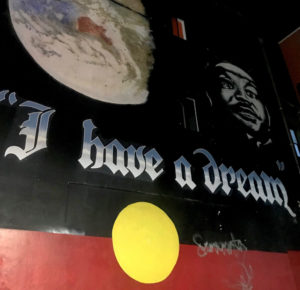
Recently taking over as the first female president of the Newtown Liquor Accord, she champions the local business community for maintaining the suburb’s night time economy over the last five years. “The biggest thing is that Newtown was really agile to the changes when the lockout laws happened. We decided as a Liquor Accord to do self-imposed 3 am lockouts to show that we were proactive.”
Last year, the Liquor Accord also banned party bus groups from entering venues in Newtown. “There’s a lot of pre-loading by the time they get here, and there’s a lot of refusing party buses on the door, so then there are 30 people on the street,” explains Verratti.
The need to keep large groups of intoxicated patrons off Newtown’s thoroughfare King Street has been a priority for businesses in the area. “Even when the lockout laws happened, that shit didn’t happen in the venue. It happened out on the street,” she says.
A Liquor Accord WhatsApp group connects licensees, managers and security guards from every Newtown venue. From the Lansdowne, through King Street, down to the Union Hotel and the Vic on the Park, venues communicate directly to keep the area safe from anti-social behaviour.
And the number of security guards across Newtown venues has increased to accommodate the influx of night time visitors.
As the Joint Select Committee reports: “Another element of Newtown’s successful night time economy was a shared vision and commitment by business owners to proactively take control of the standard of patron behaviour in Newtown.”
“Newtown was a pioneer for safe spaces,” says Verratti. “We have no tolerance for bullshit like racism and homophobia.”
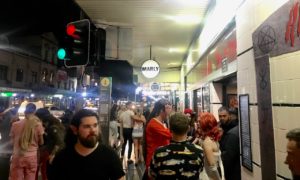
But Verratti admits it was a steep learning curve for venues adjusting to the new clientele. “It was a really interesting demographic shift,” she explains. “You’ll find on a Friday or Saturday night many fewer people from Newtown out and about.”
The publican knows all about some of the ugly and violent behaviour that can occur on King Street some weekends. “When I was working at a pub in Newtown [she’s reluctant to say which], it was known for being quite aggressive. It was probably the worst time I’ve ever had working on the door at a venue in my entire hospitality career.”
Today, as King Street venues continue to fill up on weekends, Verratti says venues and the new crowds have adjusted to each other. “At The Bank, we’ve reduced our security guards in the past four months. We feel a lot more comfortable with people coming into our venue,” she says. “I think the learning has been done over the past four years.”
For some, the increased number of city-displaced patrons on weekends continues to create concern for safety.
“You need to have your wits about you a bit more in Newtown on a Friday or Saturday night than you used to,” says Greg Khoury, executive director for Century Venues. “And I think a lot of the locals have found that fairly intimidating and intrusive.”
A change in late-night clientele was inevitable after the lockout laws, but Khoury acknowledges the efforts of Newtown’s hospitality industry in maintaining the suburb’s unique vibe. “I think the hoteliers here feel very responsible for the area,” he says.
Currently a Sydney Fringe board member, Khoury has worked and lived in Newtown all his life and today oversees the iconic Enmore Theatre and the University of Sydney’s Manning Bar. He is also a founding member of the Newtown Entertainment Precinct Association and is a trustee for the Old 505 Theatre at 5 Eliza Street. Newtown’s diverse and inclusive identity comes from the history of its residents, he says.
Alongside the energetic student population in the area, drawn in by the nearby universities, were post-war immigrants from Europe. “Students and hippies of the late ’60s and ’70s were equally comfortable alongside 60 and 70 year-old Ukrainians, Yugoslavs, Greeks and Italians.”
That co-existing “melting pot”, as Khoury describes it, “has been a definer of Newtown, because it meant acceptance and tolerance of people.” A walk down bustling King Street on any afternoon demonstrates the area’s welcoming diversity.
Khoury also credits Dawn O’Donnell, “who more or less created Oxford Street”, for deciding to buy and open gay-oriented venues in Newtown such as the Imperial and Newtown Hotel in the 1980s.
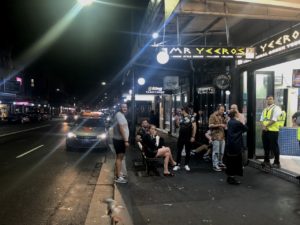
This explains the ‘Newtown vibe’, difficult to describe to someone who has never visited the suburb, but something King Street businesses work hard to maintain. So much so that the Newtown Vibe Roundtable, comprised of council and state government representatives, police and businesses, sent in a report to the recent Joint Select Committee titled: ‘Protecting the vibe’. Its objectives include developing initiatives to respond to increased visitor numbers and “patronage of local venues”, guided by the principle that, “Newtown is unique, but not exclusive. We want to make sure we keep it weird, open, and safe”.
To this day, King Street remains a central hub and spiritual home for the LGBTQIA+ community. “I don’t know if I would have had a chance to explore my queer identity anywhere else like I have in Newtown,” says James Sinclair, who identifies as non-binary. Since being born at neighbouring Royal Prince Alfred Hospital, Sinclair has never left the Newtown community, living and working in the local area their whole life. “In certain spaces in Newtown I feel very safe and protected, and I know all the bar staff would have my back if anything happened.”
So, how will the next five years shape the area?
There’s no doubt that Newtown has gentrified over the years, but by keeping its weirdness, colour and community, it can remain unique says Khoury: “I think the more corporatisation there is in Sydney, the more places like Newtown remain very attractive.”
Verratti agrees, saying the influx of people to the bohemian Inner West suburb will continue, “because people just want to belong somewhere”.
The Berejiklian Government’s response to the lock out laws report is due by March 30, 2020. How it will change Sydney’s nightlife remains to be seen.

